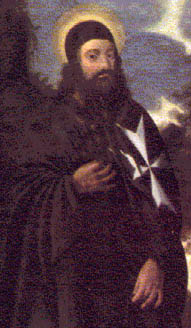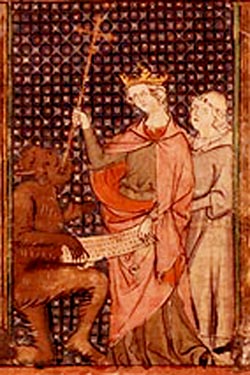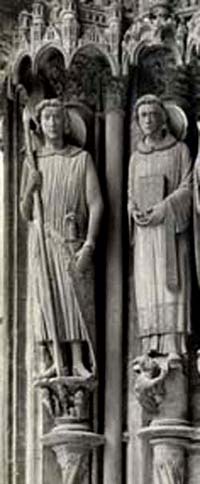 |
The Saint of the Day
Blessed Gerard Mecatti of Villamagna
May 23
Prof. Plinio Corrêa de Oliveira
Biographical selection:
Gerard was born in 1174 in Villamagna, Tuscany, the son of peasants. He lost his parents at age 12 and was educated by the noble family of Folci, to whom Gerard’s parents were linked by feudal bonds.
The head of the family went on the Third Crusade and took with him Gerard, whom he esteemed. In the Holy Land they endured many sufferings, including imprisonment. They were ransomed, but Gerard’s noble protector died in Jerusalem, and the young crusader returned to Florence.
Twelve years passed, and another knight asked Gerard to accompany him on the Crusade since he had great trust in Gerard’s prayers. He agreed.

Even when he was a hermit Gerard never stopped wearing his crusader cross
|
On the journey by sea, they faced Muslim pirates whose forces were much superior to their own. Under the command of Gerard, the Catholics brilliantly defeated them. For seven years Gerard remained in Syria helping the Catholic pilgrims. During this period he entered the Order of St. John of Jerusalem, where he received great eulogies for his good actions. This made him fear for the salvation of his soul.
So, he returned to Italy and became a hermit, but he always wore on his garments the white cross of the crusader. He lived for a long time assisting pilgrims who would come to him asking for counsel. He worked many miracles and received the gift of prophecy. He dedicated himself to prayers, alms and penances.
In Florence he helped St. Phillip Benisi to establish a confraternity in honor of Our Lady. Twice he became mortally ill, but each time he prophesized his cure and recovered. The third time, however, he announced that he would die. He passed away on May 30, 1254 at age 90, shortly after saying a prayer to the Mother of God.
It was necessary to set up a guard to keep order at his funeral, given the multitude of persons who loved him and came to see his body. So abundant were the alms given by his admirers that a magnificent church was built over a tomb that he had ordered made for himself.
The inhabitants of Villamagna had an extraordinary devotion to Gerard. Even though this church was destroyed many times, it was always rebuilt. He became the protector of the region and prevented many pestilences and natural disasters. He was beatified in 1833.
Comments of Prof. Plinio:
The life of Blessed Gerard brings us into the presence of another warrior saint. With the sentimental mentality that dominates large segments of today’s Catholic spirit, the lives of military saints have been almost forgotten, virtually put aside. We hear almost nothing about them. There is devotion to St. Michael, who vanquished the Devil and cast him in Hell. But since he is an Angel, this sentimental humanitarism is not applied so much to him. Still, this type of piety tries to avoid analyzing St. Michael’s fight or dwelling on the details of how completely he chastised the Devil.

Our Lady thrusts a spear in the throat of the Devil and saves the monk Theophilus
|
It is very rare to find a church dedicated to a Crusader Saint, with a statue of him in his armor, sword and spear on the principal altar so that the faithful can go there and pray to him for the virtue of fortitude. If one of you knows about such a church, I would like to have data about it.
If I were wealthy, I would build a church for a Crusader Saint with his statue on the main altar, and on top of it another statue of Our Lady Queen of the Crusades, like the one of Our Lady saving the monk Theophilus from the claws of the Devil. On the side altars would be statues of other military saints in their various helmets with feathers, armor, shields, etc. I believe that it would be a very popular church which would bring many people to the Catholic Church, persons who are neglected today because they are not attracted by sentimental piety.
What did it mean to be a crusader at the time of Blessed Gerard of Villamagna? First, there was the risk of being wounded or killed that exists in any military expedition. But second, there was the risk of being caught by the Moors and being made a slave. A man caught in Syria, for example, could be sent to a slave market in Egypt or even further, to India or China, at the discretion of the slave merchant. It meant being in pagan countries far from any religious assistance.
Often such crusader prisoners were exposed to serious temptations when they became slaves of sensual ladies, who believed they had the right to use them to satisfy their desires. The prisoners would be tortured and killed if they resisted. So, they would be obliged to sin in order to satisfy their owners. We can easily imagine the consequences for their spiritual lives: to die in mortal sin without the possibility of confession. They went on the Crusade trusting in the mercy of Our Lady, asking her not to abandon them. Notwithstanding, to be a slave of pagans was an enormous risk, one that demanded true heroism to face.

At left, the warrior St. Theodore at Chartres Cathedral
|
Blessed Gerard joined the Crusade twice. If he would have gone only once, most probably the current dominated by sentimental piety would say that he never really wanted to go on the Crusade; he was obliged to accompany his noble lord. And he would have become a hermit to make penance for being a crusader.
But this is not the truth. He was so certain that going on the Crusade was the will of God that after 12 years, he went again voluntarily with another friend to do precisely the same that he had done before: fight to destroy the dominion of the Moors over the Holy Land and help Catholic pilgrims. The selection says that he became renowned for his good actions there. It is a way to say that he was a very good warrior on the battlefield who played his part in the important Catholic military victories. The selection pointed out that on the journey to the Holy Land he was the one who commanded the counter-attack against pirates and brilliantly defeated them. He became also a member of the chivalric Order of St. John of Jerusalem, later also known as the Order of Malta. Therefore, Blessed Gerard Mecatti of Villamagna was a valorous warrior.
His valor was such that he began to receive so many eulogies that he feared this would make him proud and put his salvation at risk. Therefore, the wise knight who feared neither the Moors nor becoming a slave, feared eulogies. How true it is that eulogies are often more difficult to resist than an enemy in war!
For this reason he returned to Italy and became a hermit. Again his behavior edified the faithful, who were impressed by his holy life, his expansive charity and generous alms, and even more than the alms, the advice he would dispense to the many persons who sought him out.
I am sure that the prestige of having been a veteran crusader - he always wore the crusader cross - contributed to the general veneration he received from the population of Tuscany. His fame grew with time, and when he died, it had reached a kind of apotheosis. This can be seen in the multitudes that came to see his body for the last time. The crowds swarmed the small village of Villamagna and the authorities had to set up special guards to control the unexpected flood of people.
Let us ask Blessed Gerard Mecatti to help us admire the beauty of the military fight for the glory of God and Our Lady, to give us fortitude to wage the war against the Revolution in our days, and to flee from the subtle dangers of pride and vanity in order to please Our Lady in everything we do, as he did.


  | | Prof. Plinio Corrêa de Oliveira | |
The Saint of the Day features highlights from the lives of saints based on comments made by the late Prof. Plinio Corrêa de Oliveira. Following the example of St. John Bosco who used to make similar talks for the boys of his College, each evening it was Prof. Plinio’s custom to make a short commentary on the lives of the next day’s saint in a meeting for youth in order to encourage them in the practice of virtue and love for the Catholic Church. TIA thought that its readers could profit from these valuable commentaries.
The texts of both the biographical data and the comments come from personal notes taken by Atila S. Guimarães from 1964 to 1995. Given the fact that the source is a personal notebook, it is possible that at times the biographic notes transcribed here will not rigorously follow the original text read by Prof. Plinio. The commentaries have also been adapted and translated for TIA’s site.
|
Saint of the Day | Home | Books | CDs | Search | Contact Us | Donate

© 2002- Tradition in Action, Inc. All Rights Reserved
|
 |

|